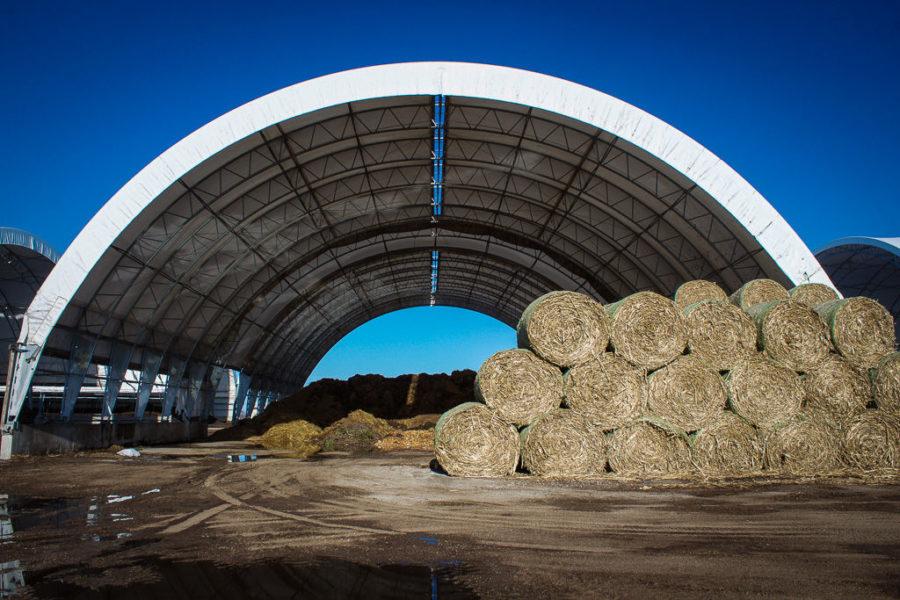Compost Facility helps create sustainable campus
Corn stalk is the main contributor to compost. Used for hay bales, corn stalk is recycled to feed livestock.
April 22, 2018
The Iowa State Compost Facility receives four to five tons of food waste from campus dining centers almost every other day.
These food scraps travel from the dining centers to the facility located less than ten minutes from campus. The Compost Facility is one of Iowa State’s research farms and is located west of the dairy farm and is right across the road from the student run Ag Studies 450 farm.
Steve Jonas, manager of the Compost Facility, said the workers at the nearby farms all do their own thing, but are still able to collaborate as a team.
Collaboration is especially key for the Compost Facility in relation to Iowa State’s Dairy Farm.
The facility was originally built to handle waste from when the Dairy Farm was newly opened. There needed to be a way to repurpose the large amount of cow manure instead of just wasting it.
Miguel Luis Rangel-Mendez, a program coordinator in the animal science department, has been managing the Dairy Farm for three months.
“We don’t have enough land for the manure, so we need the compost facility to compost some of the manure,” Rangel-Mendez said.
The Dairy Farm is benefited by having the facility on campus, but it’s close proximity makes it that much more convenient.
“Iowa State wanted to add a compost facility, so it worked perfectly to add the facility that we needed right next to the Dairy Farm,” Leo Timms, Morrill Professor and Extension Dairy Specialist, said.
Steve Jonas is an agricultural specialist as well as the manager of the facility. He has been managing the farm since 2009. The facility was built in 2008 and is coming up on its ten year anniversary.
In the beginning stages of the compost farm, it took a little while to see what would be the most efficient way to get the right results.
It was a lot of trial and error to see what worked at first, Jonas said.
Today, the facility handles more than 10,000 pounds of compost waste every year.
The food scraps from the dining centers are then combined with waste from other places around Iowa State. Campus greenhouses, other research farms and Jack Trice stadium all contribute waste to the compost farm. The facility only takes waste that comes from the university and charges a small fee on whatever enters the the farm.
The waste from around campus is then combined with manure and cornstalks.
The cornstalks create the major source of carbon for the compost, Jonas said.
This combination is then put into long rows called “windrows” underneath large hoop barns. These barns help to protect the compost from the weather and keep the temperature at 140-160 degrees.
“Keeping them in windrows helps the pile to breathe,” Jonas said.
There are three separate windrows inside each barn. Jonas uses a compost turner to incorporate even more air into the piles.
The compost facility is open all year long. However, winter and spring can cause issues with the often unpredictable weather. There needs to be the right balance of moisture within the compost in order for the waste to decompose properly.
“We usually have an issue of too much moisture if anything,” Jonas said.
At the end of the process, the compost is mixed with topsoil. It is lighter, softer, and drier than it was a couple of months ago. Then it is screened to make sure no rocks or other large items are in it.
“It takes about four months to go from start to finish,” Jonas said.
The final product is not available to the public. It goes back into Iowa State and is used for construction projects, gardens or anything the university needs.
“We use manure in the field to fertilize. And the compost facility, they use that compost, manure to fertilize campus,” Rangel-Mendez said.
By only taking waste from Iowa State, farming it all on campus, and then giving it back to only university-related needs, the compost facility aims to help Iowa State be as sustainable as possible.
“It’s the recycling aspect of it,” Jonas said. “It all stays within the university.”
















